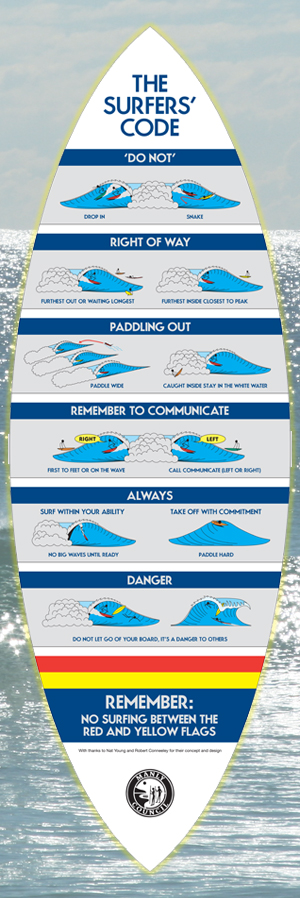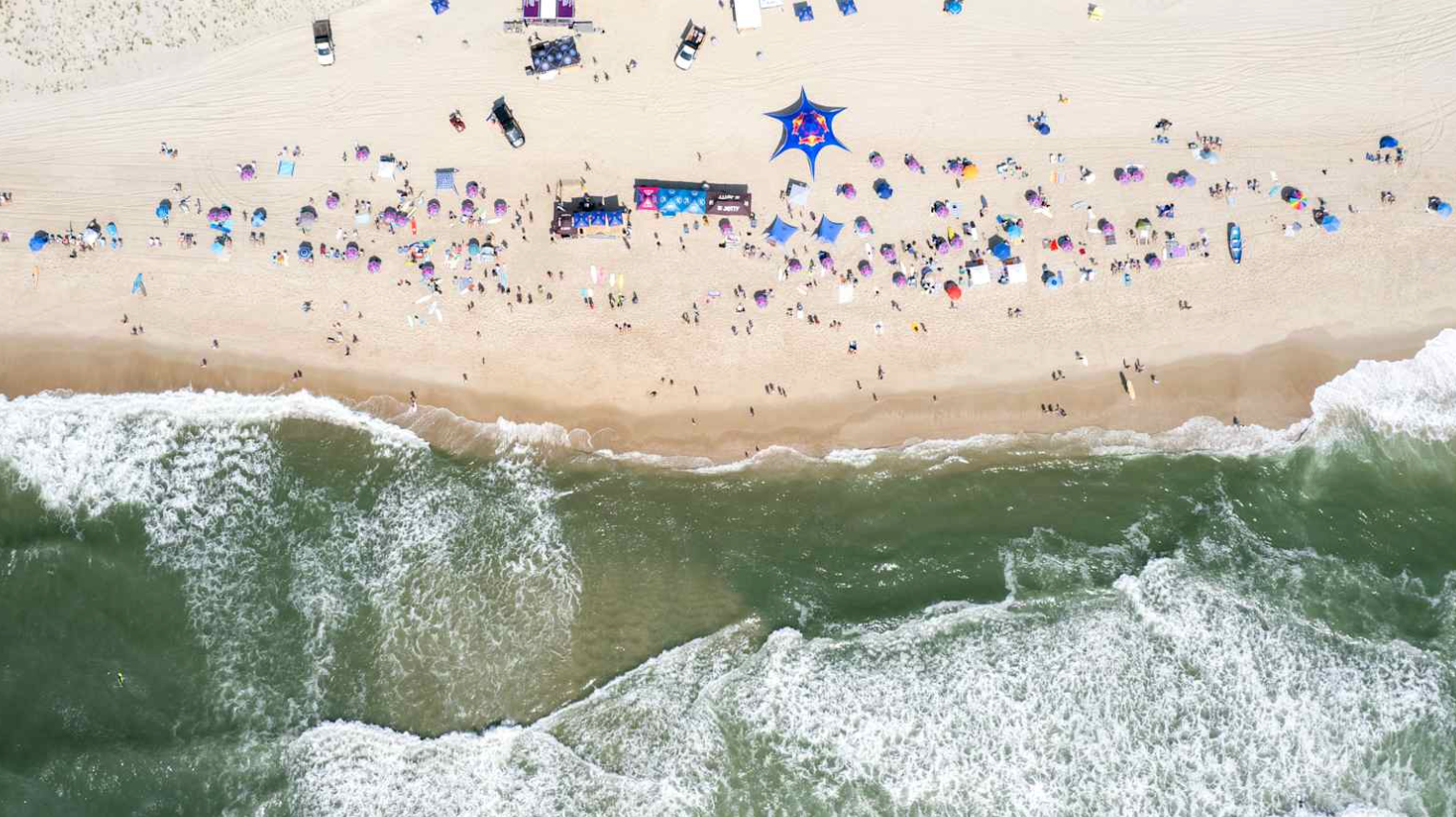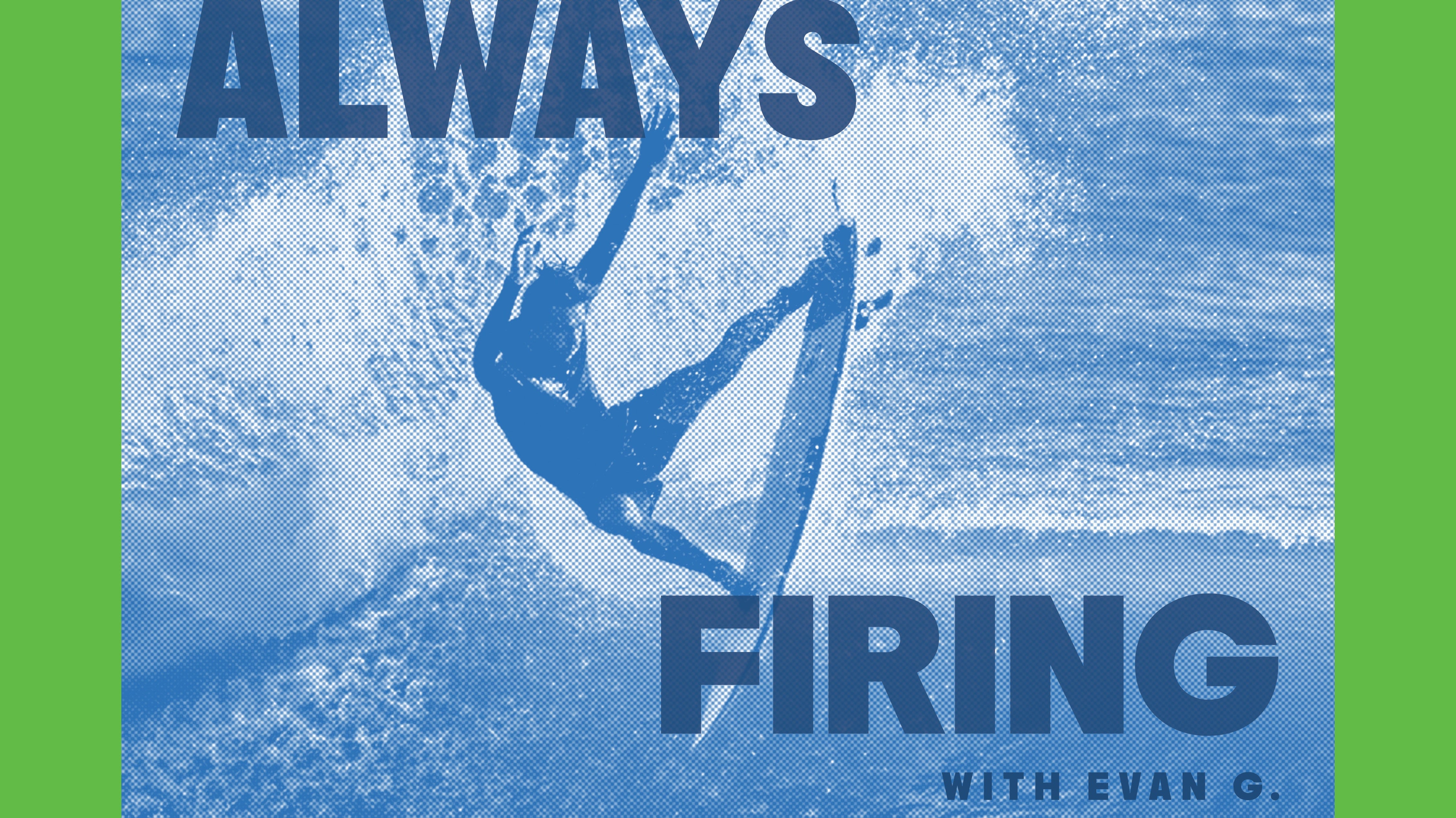Dos & Dont's of Surfing
Sometime rules are a means to end total chaos. Many things also have underlining or unspoken rules of "do's" and "dont's". Today we will talk about Surf Etiquette...the unwritten laws that keep you out of trouble when you are in the water and ensure you have more fun than drama when you surf.

The Surfer's Code Sign from Ft Pierce, FL
Right of Way:
When you are out in the water, it is important to learn who has the "right of way" on a wave. To make it simple, we put together a little list in order of priority:
Dropping In:
Never cut in front of other surfers who are up and riding a wave. This is a sure was to get the locals a little angry.
Don't Snake Others:
Snaking happens when you paddle around someone to get into the inside position on a wave. This is definitely a no-no.
Wave Hog:
Do not take all the waves. You should have learned how to share in kindergarten, but if not, learn now! Even if you can paddle furthest outside and technically have priority, give others a chance to have some fun too.
Apologize:
Mind your manners. If you drop in on someone, run over someone, or breach the unwritten rules in any way, just apologize.
Respect the Locals:
Keep in mind that the locals surf the spot every day. You are on their home turf. So, be kind and respectful.
Paddling Out:
Paddle wide, head out around the wave, and do not get into a surfer's path who is riding the wave. It is always easier to paddle through unbroken water. So, before you start paddling out, take a good look at how the waves are breaking and determine the best way to get out without getting in the way.
Surf Within Your Ability:
When you surf, pick the spot and day according to your ability. Do not surf big waves until you are ready. Surfing out of your ability just causes you to get in the way or makes you a potential hazard to others or yourself.
Help other Surfers:
Always help another surfer in trouble! Surfing can be dangerous, so, look after each other.
Respect the Beach & Have Fun:
Leave only footprints. Be a good steward of the amazing ocean that God gave use. Pick up your trash and do not cause intentional damage to the beach, reef or areas we love to surf. Head out and have fun!
Furthest out:
The surfer that is furthest out or that has been waiting longest
Furthest inside:
The closest surfer to the peak of the breaking wave
First to feet:
The first surfer to their feet or first onto the wave
Communication:
If someone calls of "Left!" or "Right!" if the wave is dual-peaking
The Unwritten Rules of Surfing – courtesy of Totalsurfingfitness.com
Surf Etiquette is so important that the City of Deerfield Beach shares these tips on their website:
To help ensure the safety of all beach patrons, the City of Deerfield Beach requires that all surfboards and bodyboards must be used with a leash.
Surfers who do not use a leash greatly increase the likelihood of a loose board in the lineup, which could cause severe damage to other people and boards. This policy includes the surfing areas north of the International Fishing Pier and on the south side of lifeguard tower #9. Please remember at all times to be responsible for your equipment and respectful of others.
Pick the right surfing spots for your ability and attitude. We need to be honest with ourselves about our ability. We also need to recognize that some surf zones are not suited to competitive skills-oriented behavior.
When it comes to selecting a surf spot for the day's fun, each of us has a responsibility to be aware of where we'll feel most comfortable. Surf spots with hollow, more powerful, high performance wave ranges – North of the International Pier, for instance - will almost always feature a higher-skilled and more potentially competitive group of surfers. Generally at such “Hot Zones,” the better the surfers' general skills, more waves will be ridden per surfer and more pressure will be on each individual surfer to keep up the pace.On the other end of the spectrum, “Cool Zones,” surf spots with softer, easier and less critical wave ranges – south of Tower #9 – will usually feature beginners or intermediate surfers. This will allow the atmosphere in the lineup to be much more relaxed, with considerably less performance pressure on the individual.
It's important for all of us to recognize that by charging into a lineup for which we're not suited, we're likely to be frustrated and to disrupt others' surfing enjoyment. If you're not a high performance surfer, but just engaging in the early learning process, then tackling a “Hot Zone” will leave you feeling way out of your depth and may even place you or other surfers in danger of injury. If you're a budding hot surfer trying to develop a high skill range and eager to ride with people of a similar intent, then paddling out at a Cool Zone is likely to leave you feeling unsatisfied and your fellow surfers irritated by your competitive attitude.
Don't drop in on your fellow surfer. In other words, do not catch a wave once another surfer has claimed it by being in a deeper or more effective position at takeoff.
The drop-in happens like this: Surfer A is closest to the curl or the place where the wave begins to crest, paddles into and catches the wave, only to find that Surfer B – the dropper-in – has also caught the wave, from further out on the shoulder. Surfer A is then blocked from making a successful ride. The two surfers may collide, accidentally or deliberately, but it's unlikely that either will enjoy the wave to its fullest. At some critical surf spots, Surfers A and/or B may even be placed in physical danger as a result.
Drop-ins can and do happen by accident, as well as through frustration and confusion in a crowded lineup. To avoid dropping in, practice the three Ls: Look, Listen, and Learn. Always Look to your inside toward the curl before committing to the wave, just to make sure no one has claimed the wave before you. Listen for the common warning – a hoot or whistle from the surfer in position. Learn from your errors - if you drop in, make sure you're off the wave as soon as possible, say sorry, and make sure the other rider's OK before going on with your session.
A more subtle, yet potentially more offensive form of ride interference is the intentional drop-in. This move is very bad etiquette, a greedy exploitation of the generally understood drop-in rule, and is usually practiced by competent and aggressive surfers. Surfer A, in position and having waited his or her turn, begins to paddle for the wave. Surfer B waits until A's focus is purely on catching the wave, then makes a quick move to the inside and takes off, claiming the wave. If both surfers end up riding, it appears A has dropped in and is in the wrong, yet both surfers, and usually most onlookers, know otherwise. If you're being dropped-in on repeatedly by a single surfer, don't react -- it's unlikely to be personal. Simply move to another area of the break, putting yourself out of each other's wave-catching rhythm. If you find yourself being persistently snaked by a range of surfers, you may be sitting too wide off the takeoff to fully claim the wave; paddle deeper and make your intention clearer.
Special note to beginners: You may occasionally note surfers breaking these drop-in codes, riding around each other, and grinning away in the process -- obviously enjoying the wave share. Very likely they're friends or acquaintances who've taken off on the same wave deliberately, or who are making the best of an accidental drop-in. This should NOT be a signal to you that dropping in is just fine at that particular spot.
At all times, be responsible for your equipment and respectful of others. If it's ignored or treated as something other than a wave-riding craft, a surfboard can be damaged - or do severe damage to other boards and people. First and simplest to recall: never let your surfboard go. Throwing your board and relying on your leash to get through a closeout or broken wave's whitewater is a very bad call in all but the least crowded and most critical of circumstances. Any other surfer within 10 or more yards, particularly behind you, is immediately placed in serious danger; and there's a chance the leash may break or otherwise un-attach itself, in which case your board's a loose cannon. This especially applies to riders of thick, heavy equipment, such as traditional longboards. You should consider the possibility that if you can't negotiate a surf spot without throwing your board away, the spot may not be for you. We're all free to endanger ourselves as much as we like, but super sharp fin edges, broken glass poking out of unfixed dings, and snapped-off noses can be dangerous to other surfers too. Such flaws can result in nicks or cuts to your leash, increasing the likelihood of a loose board in the lineup. Always do your best to make good on any damage caused by your surfboard to someone else's board by arranging for a repair job.



